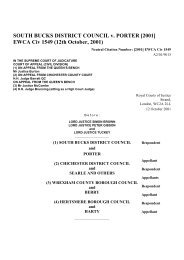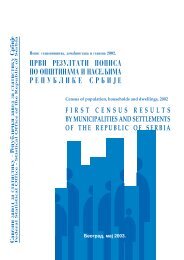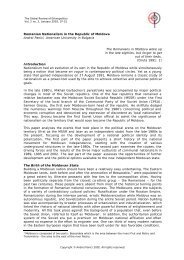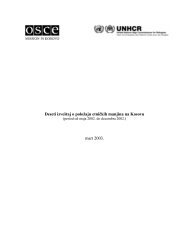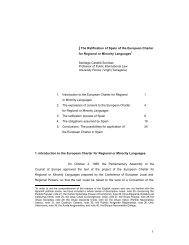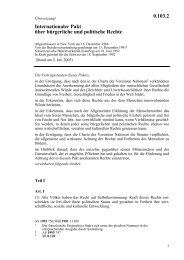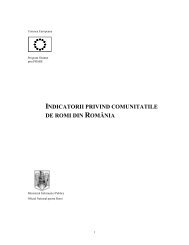Final Report of the International Commission on the - Minority Rights ...
Final Report of the International Commission on the - Minority Rights ...
Final Report of the International Commission on the - Minority Rights ...
You also want an ePaper? Increase the reach of your titles
YUMPU automatically turns print PDFs into web optimized ePapers that Google loves.
soldiers,” deserters, “degenerate elements in <str<strong>on</strong>g>the</str<strong>on</strong>g> police force,” Legi<strong>on</strong>naires and “inebriated civilians.”<br />
d) Unlike in <str<strong>on</strong>g>the</str<strong>on</strong>g> 1950s and 1960s, <str<strong>on</strong>g>the</str<strong>on</strong>g> 1970s and particularly <str<strong>on</strong>g>the</str<strong>on</strong>g> early 1980s mark a qualitative<br />
separati<strong>on</strong> <str<strong>on</strong>g>of</str<strong>on</strong>g> <str<strong>on</strong>g>the</str<strong>on</strong>g> Legi<strong>on</strong>ary and Ant<strong>on</strong>escu regimes respectively, with a severe bias against <str<strong>on</strong>g>the</str<strong>on</strong>g> former.<br />
The Legi<strong>on</strong>naires are depicted through <str<strong>on</strong>g>the</str<strong>on</strong>g> usage <str<strong>on</strong>g>of</str<strong>on</strong>g> adjectives that evoke marginality and<br />
unrepresentativeness: “bandits,” “hooligans,” “robbers,” “murderers,” “terrorists,” “traitors,” “fifth<br />
column <str<strong>on</strong>g>of</str<strong>on</strong>g> Hitlerism.” The authors insist that for <str<strong>on</strong>g>the</str<strong>on</strong>g> Legi<strong>on</strong>naires ideology was nothing but an “excuse”<br />
for <str<strong>on</strong>g>the</str<strong>on</strong>g>ir reprehensible deeds. By c<strong>on</strong>trast, Ant<strong>on</strong>escu appears less bloodthirsty and irresp<strong>on</strong>sible,<br />
although menti<strong>on</strong> is made <str<strong>on</strong>g>of</str<strong>on</strong>g> some <str<strong>on</strong>g>of</str<strong>on</strong>g> <str<strong>on</strong>g>the</str<strong>on</strong>g> crimes committed under his command. While <str<strong>on</strong>g>the</str<strong>on</strong>g> deeds <str<strong>on</strong>g>of</str<strong>on</strong>g><br />
Legi<strong>on</strong>naires are depicted as being committed out <str<strong>on</strong>g>of</str<strong>on</strong>g> a gratuitous propensity to kill, <str<strong>on</strong>g>the</str<strong>on</strong>g> crimes committed<br />
during Ant<strong>on</strong>escu’s dictatorship are placed in <str<strong>on</strong>g>the</str<strong>on</strong>g> c<strong>on</strong>text <str<strong>on</strong>g>of</str<strong>on</strong>g> <str<strong>on</strong>g>the</str<strong>on</strong>g> state <str<strong>on</strong>g>of</str<strong>on</strong>g> emergency, which intimates that<br />
<str<strong>on</strong>g>the</str<strong>on</strong>g> C<strong>on</strong>ducator had limited freedom <str<strong>on</strong>g>of</str<strong>on</strong>g> acti<strong>on</strong> and that his decisi<strong>on</strong>s were motivated by <str<strong>on</strong>g>the</str<strong>on</strong>g> war as well as<br />
domestic and internati<strong>on</strong>al circumstances.<br />
e) Antisemitism is <strong>on</strong>ly seldom presented as an ingredient <str<strong>on</strong>g>of</str<strong>on</strong>g> fascism. For example, in <str<strong>on</strong>g>the</str<strong>on</strong>g> book <strong>on</strong> <str<strong>on</strong>g>the</str<strong>on</strong>g><br />
Legi<strong>on</strong>, antisemitism is menti<strong>on</strong>ed last am<strong>on</strong>g a l<strong>on</strong>g list <str<strong>on</strong>g>of</str<strong>on</strong>g> o<str<strong>on</strong>g>the</str<strong>on</strong>g>r defining features <str<strong>on</strong>g>of</str<strong>on</strong>g> fascism; it is listed<br />
<strong>on</strong>ly after anticommunism, hostility to democracy, irrati<strong>on</strong>ality, mysticism, anti-nati<strong>on</strong>al character,<br />
hostility to <str<strong>on</strong>g>the</str<strong>on</strong>g> working class, <str<strong>on</strong>g>the</str<strong>on</strong>g> cult <str<strong>on</strong>g>of</str<strong>on</strong>g> death, anti-intellectualism, and <str<strong>on</strong>g>the</str<strong>on</strong>g> apology <str<strong>on</strong>g>of</str<strong>on</strong>g> war. Even when<br />
menti<strong>on</strong> is made <str<strong>on</strong>g>of</str<strong>on</strong>g> antisemitism, <str<strong>on</strong>g>the</str<strong>on</strong>g> trait is depicted as being aimed at “c<strong>on</strong>cealing <str<strong>on</strong>g>the</str<strong>on</strong>g> real causes <str<strong>on</strong>g>of</str<strong>on</strong>g> <str<strong>on</strong>g>the</str<strong>on</strong>g><br />
ec<strong>on</strong>omic, social and political crises <str<strong>on</strong>g>of</str<strong>on</strong>g> those years” and at “diverting <str<strong>on</strong>g>the</str<strong>on</strong>g> attenti<strong>on</strong> <str<strong>on</strong>g>of</str<strong>on</strong>g> <str<strong>on</strong>g>the</str<strong>on</strong>g> working class<br />
from its struggle against exploiters.” In <str<strong>on</strong>g>the</str<strong>on</strong>g> book <strong>on</strong> <str<strong>on</strong>g>the</str<strong>on</strong>g> Iaşi pogrom, <str<strong>on</strong>g>the</str<strong>on</strong>g> two authors claim that it is<br />
“simplistic” and “mystifying” to speak <str<strong>on</strong>g>of</str<strong>on</strong>g> “Romanian antisemitism” at all; <str<strong>on</strong>g>the</str<strong>on</strong>g>n, in a sententious note,<br />
<str<strong>on</strong>g>the</str<strong>on</strong>g>y c<strong>on</strong>clude that “unlike in many parts <str<strong>on</strong>g>of</str<strong>on</strong>g> East-Central Europe, <str<strong>on</strong>g>the</str<strong>on</strong>g> Romanian land did not prove fertile<br />
to <str<strong>on</strong>g>the</str<strong>on</strong>g> pois<strong>on</strong>ed seeds <str<strong>on</strong>g>of</str<strong>on</strong>g> hate.” On most occasi<strong>on</strong>s, even when menti<strong>on</strong>ed antisemitism is not explained,<br />
but <strong>on</strong>ly inserted into an enumerati<strong>on</strong> <str<strong>on</strong>g>of</str<strong>on</strong>g> o<str<strong>on</strong>g>the</str<strong>on</strong>g>r traits <str<strong>on</strong>g>of</str<strong>on</strong>g> fascism. Am<strong>on</strong>g <str<strong>on</strong>g>the</str<strong>on</strong>g> books surveyed, <strong>on</strong>ly <strong>on</strong>e<br />
analyzes antisemitism as a form <str<strong>on</strong>g>of</str<strong>on</strong>g> racism and lists <str<strong>on</strong>g>the</str<strong>on</strong>g> antisemitic measures <str<strong>on</strong>g>of</str<strong>on</strong>g> that time. This volume<br />
also admits that antisemitism “became state policy as early as <str<strong>on</strong>g>the</str<strong>on</strong>g> times <str<strong>on</strong>g>of</str<strong>on</strong>g> Carol II.”<br />
f) Just as <str<strong>on</strong>g>the</str<strong>on</strong>g>y strive to diminish <str<strong>on</strong>g>the</str<strong>on</strong>g> importance <str<strong>on</strong>g>of</str<strong>on</strong>g> antisemitism in <str<strong>on</strong>g>the</str<strong>on</strong>g> fascist credo, <str<strong>on</strong>g>the</str<strong>on</strong>g> authors<br />
minimize Jewish suffering and narrow <str<strong>on</strong>g>the</str<strong>on</strong>g> scope <str<strong>on</strong>g>of</str<strong>on</strong>g> Jewish tragedy. For example, <str<strong>on</strong>g>the</str<strong>on</strong>g> History <str<strong>on</strong>g>of</str<strong>on</strong>g><br />
Romanians menti<strong>on</strong>s <strong>on</strong>ly <str<strong>on</strong>g>the</str<strong>on</strong>g> Legi<strong>on</strong>’s “pressures and brutalities against Jews.” After first referring to <str<strong>on</strong>g>the</str<strong>on</strong>g><br />
fate <str<strong>on</strong>g>of</str<strong>on</strong>g> impris<strong>on</strong>ed or executed communists and antifascists, The Compendium notes: “To <str<strong>on</strong>g>the</str<strong>on</strong>g> series <str<strong>on</strong>g>of</str<strong>on</strong>g><br />
murders committed during <str<strong>on</strong>g>the</str<strong>on</strong>g> Ant<strong>on</strong>escu dictatorship <strong>on</strong>e can add <str<strong>on</strong>g>the</str<strong>on</strong>g> pogrom organized in Iaşi, in which<br />
2,000 people, most <str<strong>on</strong>g>of</str<strong>on</strong>g> <str<strong>on</strong>g>the</str<strong>on</strong>g>m Jews, were murdered. Many o<str<strong>on</strong>g>the</str<strong>on</strong>g>r citizens <str<strong>on</strong>g>of</str<strong>on</strong>g> various nati<strong>on</strong>alities, most <str<strong>on</strong>g>of</str<strong>on</strong>g><br />
<str<strong>on</strong>g>the</str<strong>on</strong>g>m Jews, were interned in labor camps [and threatened with] exterminati<strong>on</strong> through various means.” In<br />
Garda de Fier, menti<strong>on</strong> is made <str<strong>on</strong>g>of</str<strong>on</strong>g> a well-known and well-documented incident in January 1941, during<br />
which 200 Jews were locked in a Legi<strong>on</strong>ary headquarters in Bucharest during <str<strong>on</strong>g>the</str<strong>on</strong>g> Ir<strong>on</strong> Guard’s uprising,<br />
and ninety <str<strong>on</strong>g>of</str<strong>on</strong>g> <str<strong>on</strong>g>the</str<strong>on</strong>g>m were later shot in <str<strong>on</strong>g>the</str<strong>on</strong>g> nearby Jilava forest. The two authors, historians Mihai Fătu and<br />
I<strong>on</strong> Spălăţelu, cite Carp’s Cartea neagră, but in <str<strong>on</strong>g>the</str<strong>on</strong>g>ir versi<strong>on</strong> <str<strong>on</strong>g>the</str<strong>on</strong>g> 200 Jews are turned into “200 citizens.”<br />
A few pages <strong>on</strong>, however, Fătu and Spălăţelu cite Carp correctly, menti<strong>on</strong>ing <str<strong>on</strong>g>the</str<strong>on</strong>g> number <str<strong>on</strong>g>of</str<strong>on</strong>g> <str<strong>on</strong>g>the</str<strong>on</strong>g> pogrom’s<br />
victims as 120. The C<strong>on</strong>tributi<strong>on</strong>s <str<strong>on</strong>g>of</str<strong>on</strong>g>fers <str<strong>on</strong>g>the</str<strong>on</strong>g> most informati<strong>on</strong> about <str<strong>on</strong>g>the</str<strong>on</strong>g> regime’s antisemitic policies and<br />
menti<strong>on</strong>s <str<strong>on</strong>g>the</str<strong>on</strong>g> Transnistria deportati<strong>on</strong>s, which is rare. Still, <str<strong>on</strong>g>the</str<strong>on</strong>g> terminology employed for this purpose<br />
remains ambiguous and is inaccurate: “One <str<strong>on</strong>g>of</str<strong>on</strong>g> <str<strong>on</strong>g>the</str<strong>on</strong>g> forms <str<strong>on</strong>g>of</str<strong>on</strong>g> repressi<strong>on</strong> used against <str<strong>on</strong>g>the</str<strong>on</strong>g> Jewish populati<strong>on</strong><br />
was <str<strong>on</strong>g>the</str<strong>on</strong>g> internment <str<strong>on</strong>g>of</str<strong>on</strong>g> <str<strong>on</strong>g>the</str<strong>on</strong>g> people regarded as ‘dangerous to <str<strong>on</strong>g>the</str<strong>on</strong>g> security <str<strong>on</strong>g>of</str<strong>on</strong>g> <str<strong>on</strong>g>the</str<strong>on</strong>g> state,’ which usually meant<br />
communists or antifascists, in c<strong>on</strong>centrati<strong>on</strong> camps in Transnistria (Râbniţa, Vapniarca, and o<str<strong>on</strong>g>the</str<strong>on</strong>g>rs).” In<br />
Bloody Days, <str<strong>on</strong>g>the</str<strong>on</strong>g> authors cite <strong>on</strong>e <str<strong>on</strong>g>of</str<strong>on</strong>g> Ceauşescu’s well-known references to <str<strong>on</strong>g>the</str<strong>on</strong>g> Iaşi pogrom:<br />
“Immediately after <str<strong>on</strong>g>the</str<strong>on</strong>g> beginning <str<strong>on</strong>g>of</str<strong>on</strong>g> <str<strong>on</strong>g>the</str<strong>on</strong>g> anti-Soviet war, a true pogrom was organized against antifascist<br />
forces, during which 2,000 people were killed in Iaşi.” The authors c<strong>on</strong>clude that 3,233 Jews died during<br />
<str<strong>on</strong>g>the</str<strong>on</strong>g> pogrom, although <str<strong>on</strong>g>the</str<strong>on</strong>g> documents cited (to which <str<strong>on</strong>g>the</str<strong>on</strong>g> authors had privileged access at a time when



